Digital Twin of a Gear Root Crack Prognosis
Abstract
:1. Introduction
2. Theoretical Background
2.1. Condition-Based Maintenance of Critical Rotating Machines
2.2. Vibration Analysis
2.3. Paris’ Law
2.4. Digital Twins
3. Experimental Dataset
4. The New Digital Twin
4.1. Signal Processing Stage
- The signal is converted to the order domain (analogous to the frequency domain) using discrete Fourier transform.
- The orders of the gear are extracted, and these orders are used to calculate the condition indicators.
- Two condition indicators are calculated based on the extracted gear orders. These condition indicators are defined as and , where is the synchronous average in the order domain, and represents the value at the hunting tooth order, equal to . This value is for order zero and for the first harmonic of the hunting tooth, corresponding to planet gear teeth and ring teeth. Lastly, etc.
4.2. Estimation of the Severity and Remaining Time
- 1.
- For each channel, the regular data are used to calculate the covariance matrix and the mean vector of the distribution of condition indicators.
- 2.
- For each new record in each channel, the extracted condition indicators are normalized according to the covariance matrix and mean vector calculated in Step 1.
- 3.
- A health indicator is calculated for each channel using the formula , where and are the normalized condition indicators from Step 2, and is the health indicator. is a normalizing factor that is calculated as follows: based on the regular data, its value is estimated to ensure that when reaches the warning level of 0.5, the probability of a false alarm will be [52]. This represents a statistically significant value, indicating a significant fault.
- 4.
- All health indicators of the four channels are fused together.
- 5.
- The current severity is calculated by fitting the trend of the four-channel health indicators to the crack propagation model based on Paris’ law [40,41] described in Section 2.3. It is assumed that , where the health indicator is approximately proportional to crack size, as will be demonstrated later, and is the record number. The crack growth exponent is set to 4, which is a plausible standard value for steel [40]. By separating variables ( and ) and integrating on both sides, the following solution to the differential equation is obtained: where is a constant. By rearranging the equation and denoting , we obtain the final equation .
- 6.
- The remaining time until immediate maintenance action should be taken is estimated based on the estimated curve, indicating how many records it will take for the health indicator to reach a value of 1.
4.3. Demonstration on the HUMS 2023 Benchmark Dataset
5. Summary
Author Contributions
Funding
Data Availability Statement
Acknowledgments
Conflicts of Interest
References
- Kenett, R.S.; Bortman, J. The digital twin in Industry 4.0: A wide-angle perspective. Qual. Reliab. Eng. Int. 2021, 38, 1357–1366. [Google Scholar] [CrossRef]
- Semeraro, C.; Lezoche, M.; Panetto, H.; Dassisti, M. Digital twin paradigm: A systematic literature review. Comput. Ind. 2021, 130, 103469. [Google Scholar] [CrossRef]
- Thelen, A.; Zhang, X.; Fink, O.; Lu, Y.; Ghosh, S.; Youn, B.D.; Todd, M.D.; Mahadevan, S.; Hu, C.; Hu, Z. A comprehensive review of digital twin—Part 1: Modeling and twinning enabling technologies. Struct. Multidiscip. Optim. 2022, 65, 354. [Google Scholar] [CrossRef]
- Thelen, A.; Zhang, X.; Fink, O.; Lu, Y.; Ghosh, S.; Youn, B.D.; Todd, M.D.; Mahadevan, S.; Hu, C.; Hu, Z. A comprehensive review of digital twin—Part 2: Roles of uncertainty quantification and optimization, a battery digital twin, and perspectives. Struct. Multidiscip. Optim. 2023, 66, 1. [Google Scholar] [CrossRef]
- Chinesta, F.; Cueto, E.; Abisset-Chavanne, E.; Duval, J.L.; El Khaldi, F. Virtual, Digital and Hybrid Twins: A New Paradigm in Data-Based Engineering and Engineered Data. Arch. Comput. Methods Eng. 2018, 27, 105–134. [Google Scholar] [CrossRef]
- Lim, K.Y.H.; Zheng, P.; Chen, C.H. A state-of-the-art survey of Digital Twin: Techniques, engineering product lifecycle management and business innovation perspectives. J. Intell. Manuf. 2019, 31, 1313–1337. [Google Scholar] [CrossRef]
- Mincă, E.; Filipescu, A.; Cernega, D.; Șolea, R.; Filipescu, A.; Ionescu, D.; Simion, G. Digital Twin for a Multifunctional Technology of Flexible Assembly on a Mechatronics Line with Integrated Robotic Systems and Mobile Visual Sensor—Challenges towards Industry 5.0. Sensors 2022, 22, 8153. [Google Scholar] [CrossRef]
- Segovia, M.; Garcia-Alfaro, J. Design, Modeling and Implementation of Digital Twins. Sensors 2022, 22, 5396. [Google Scholar] [CrossRef]
- Sun, Y.; Fesenko, H.; Kharchenko, V.; Zhong, L.; Kliushnikov, I.; Illiashenko, O.; Morozova, O.; Sachenko, A. UAV and IoT-Based Systems for the Monitoring of Industrial Facilities Using Digital Twins: Methodology, Reliability Models, and Application. Sensors 2022, 22, 6444. [Google Scholar] [CrossRef]
- Bado, M.F.; Tonelli, D.; Poli, F.; Zonta, D.; Casas, J.R. Digital Twin for Civil Engineering Systems: An Exploratory Review for Distributed Sensing Updating. Sensors 2022, 22, 3168. [Google Scholar] [CrossRef]
- Randall, R.B. Vibration-Based Condition Monitoring: Industrial, Automotive and Aerospace Applications, 2nd ed.; Wiley: Hoboken, NJ, USA, 2021; Available online: https://www.wiley.com/en-sg/Vibration+based+Condition+Monitoring%3A+Industrial%2C+Automotive+and+Aerospace+Applications%2C+2nd+Edition-p-9781119477556 (accessed on 20 June 2023).
- Loparo, K.A.; Adams, M.L.; Lin, W.; Abdel-Magied, M.F.; Afshari, N. Fault detection and diagnosis of rotating machinery. IEEE Trans. Ind. Electron. 2000, 47, 1005–1014. [Google Scholar] [CrossRef]
- Bechhoefer, E.; He, D. A Process for Data Driven Prognostics; MFPT: Dayton, Ohio, 2012. [Google Scholar]
- Randall, R.B. State of the art in monitoring rotating machinery—Part 1. Sound Vib. 2004, 38, 14–21. Available online: https://www.researchgate.net/publication/293551810_State_of_the_Art_in_Monitoring_Rotating_Machinery_-_Part_1 (accessed on 14 December 2023).
- Randall, R.B. State of the art in monitoring rotating machinery—Part 2. Sound Vib. 2004, 38, 10–17. Available online: https://www.researchgate.net/publication/283868453_State_of_the_art_in_monitoring_rotating_machinery_-_Part_2 (accessed on 8 September 2021).
- Villa, L.F.; Reñones, A.; Perán, J.R.; De Miguel, L.J. Angular resampling for vibration analysis in wind turbines under non-linear speed fluctuation. Mech. Syst. Signal Process. 2011, 25, 2157–2168. [Google Scholar] [CrossRef]
- Order Analysis Based on Resampling—National Instruments, (n.d.). Available online: https://www.ni.com/docs/en-US/bundle/diadem/page/genmaths/genmaths/calc_oa_resampling.htm (accessed on 16 October 2022).
- Braun, S. The Extraction of Periodic Waveforms by Time Domain Averaging. Acustica 1975, 32, 69–77. Available online: https://www.semanticscholar.org/paper/The-Extraction-of-Periodic-Waveforms-by-Time-Domain-Braun/44eeac7a5082696c2eca306c0aed68c3c0bdb814 (accessed on 20 June 2023).
- Braun, S. The synchronous (time domain) average revisited. Mech. Syst. Signal Process. 2011, 25, 1087–1102. [Google Scholar] [CrossRef]
- Kundu, P.; Darpe, A.K.; Kulkarni, M.S. A review on diagnostic and prognostic approaches for gears. Struct. Health Monit. 2021, 20, 2853–2893. [Google Scholar] [CrossRef]
- Sharma, V.; Parey, A. A Review of Gear Fault Diagnosis Using Various Condition Indicators. Procedia Eng. 2016, 144, 253–263. [Google Scholar] [CrossRef]
- Randall, R.B.; Antoni, J. Rolling element bearing diagnostics—A tutorial. Mech. Syst. Signal Process. 2011, 25, 485–520. [Google Scholar] [CrossRef]
- Matania, O.; Bachar, L.; Khemani, V.; Das, D.; Azarian, M.H.; Bortman, J. One-fault-shot learning for fault severity estimation of gears that addresses differences between simulation and experimental signals and transfer function effects. Adv. Eng. Inform. 2023, 56, 101945. [Google Scholar] [CrossRef]
- Aircraft Accident Report 2/2011—Aerospatiale (Eurocopter) AS332 L2 Super Puma, G-REDL, 1 April 2009—GOV.UK, 2011. Available online: https://www.gov.uk/aaib-reports/2-2011-aerospatiale-eurocopter-as332-l2-super-puma-g-redl-1-april-2009 (accessed on 20 June 2023).
- Report on the Air Accident Near Turøy, Øygarden Municipality Hordaland County Norway 29 April 2016 with Airbus Helicopters EC-225-LP LN-OJF Operated by CHC Helikopter Service, AIBN Report SL 2018/04, 2018. Available online: https://www.sintef.no/globalassets/project/hfc/2018-04-ln-ojf-aibn-2018-rapport-om-luftfartsulykke-nar-turoy-29-april-2016-med-airbus-helicopters-ec-225-lp.pdf (accessed on 20 June 2023).
- HUMS2023 Data Challenge, Defense Science and Technology Group (DSTG), Australian Government. (n.d.). Available online: https://humsconference.com.au/HUMS2023datachallenge/ (accessed on 20 June 2023).
- Jardine, A.K.S.; Lin, D.; Banjevic, D. A review on machinery diagnostics and prognostics implementing condition-based maintenance. Mech. Syst. Signal Process. 2006, 20, 1483–1510. [Google Scholar] [CrossRef]
- Kumar, S.; Goyal, D.; Dang, R.K.; Dhami, S.S.; Pabla, B.S. Condition based maintenance of bearings and gears for fault detection—A review. Mater. Today Proc. 2018, 5, 6128–6137. [Google Scholar] [CrossRef]
- Randall, R.B. Section 1.2: Maintenance Strategies. In Vibration-Based Condition Monitoring: Industrial, Automotive and Aerospace Applications, 2nd ed.; Wiley: Hoboken, NJ, USA, 2021; pp. 2–3. Available online: https://www.wiley.com/en-us/Vibration+based+Condition+Monitoring%3A+Industrial%2C+Automotive+and+Aerospace+Applications%2C+2nd+Edition-p-9781119477556 (accessed on 23 October 2023).
- Tahan, M.; Tsoutsanis, E.; Muhammad, M.; Karim, Z.A.A. Performance-based health monitoring, diagnostics and prognostics for condition-based maintenance of gas turbines: A review. Appl. Energy 2017, 198, 122–144. [Google Scholar] [CrossRef]
- Carden, E.P.; Fanning, P. Vibration Based Condition Monitoring: A Review. Struct. Health Monit. 2004, 3, 355–377. [Google Scholar] [CrossRef]
- Randall, R.B. Section 1.4: Types and Benefits of Vibration Analysis. In Vibration-Based Condition Monitoring: Industrial, Automotive and Aerospace Applications, 2nd ed.; Wiley: Hoboken, NJ, USA, 2021; pp. 6–9. Available online: https://www.wiley.com/en-us/Vibration+based+Condition+Monitoring%3A+Industrial%2C+Automotive+and+Aerospace+Applications%2C+2nd+Edition-p-9781119477556 (accessed on 11 November 2023).
- Randall, R.B. Rolling element bearing diagnostics. In Vibration-Based Condition Monitoring—Industrial, Aerospace and Automotive Applications, 1st ed.; Wiley: Chichester, UK, 2010; pp. 200–2013. [Google Scholar] [CrossRef]
- Bonnardot, F.; El Badaoui, M.; Randall, R.B.; Danière, J.; Guillet, F. Use of the acceleration signal of a gearbox in order to perform angular resampling (with limited speed fluctuation). Mech. Syst. Signal Process. 2005, 19, 766–785. [Google Scholar] [CrossRef]
- Randall, R.B. Section 5.3.1: Time Synchronous Averaging. In Vibration-Based Condition Monitoring: Industrial, Automotive and Aerospace Applications, 2nd ed.; Wiley: Hoboken, NJ, USA, 2021; pp. 178–180. Available online: https://www.wiley.com/en-us/Vibration+based+Condition+Monitoring%3A+Industrial%2C+Automotive+and+Aerospace+Applications%2C+2nd+Edition-p-9781119477556 (accessed on 21 October 2023).
- Braun, S. Section 6.2: Time Domain Averaging (TDA). In Mechanical Signature Analysis: Theory and Applications; Academic Press: Cambridge, MA, USA, 1986; pp. 142–149. Available online: https://cris.technion.ac.il/en/publications/mechanical-signature-analysis-theory-and-applications (accessed on 24 November 2023).
- Braun, S. Chapter 6: Time Domain Averaging (Synchronous Averaging). In Discover Signal Processing: An Interactive Guide for Engineers; Wiley: Hoboken, NJ, USA, 2008; pp. 265–269. Available online: https://www.wiley.com/en-us/Discover+Signal+Processing%3A+An+Interactive+Guide+for+Engineers+-p-9780470519707 (accessed on 14 November 2023).
- Bechhoefer, E.; Kingsley, M. A review of time synchronous average algorithms. Annu. Conf. Progn. Health Manag. Soc. 2009, 1, 1–10. Available online: https://papers.phmsociety.org/index.php/phmconf/article/view/1666 (accessed on 14 December 2023).
- McFadden, P.D. A revised model for the extraction of periodic waveforms by time domain averaging. Mech Syst Signal Process. 1987, 1, 83–95. [Google Scholar] [CrossRef]
- Paris, P.; Erdogan, F. A Critical Analysis of Crack Propagation Laws. J. Basic Eng. 1963, 85, 528–533. [Google Scholar] [CrossRef]
- Beden, S.M.; Abdullah, S.; Ariffin, A.K. Review of Fatigue Crack Propagation Models for Metallic Components. Eur. J. Sci. Res. 2009, 28, 364–397. Available online: https://www.researchgate.net/publication/242085621_Review_of_Fatigue_Crack_Propagation_Models_for_Metallic_Components (accessed on 10 November 2023).
- Tao, F.; Sui, F.; Liu, A.; Qi, Q.; Zhang, M.; Song, B.; Guo, Z.; Lu, S.C.Y.; Nee, A.Y.C. Digital twin-driven product design framework. Int. J. Prod. Res. 2019, 57, 3935–3953. [Google Scholar] [CrossRef]
- Yi, Y.; Yan, Y.; Liu, X.; Ni, Z.; Feng, J.; Liu, J. Digital twin-based smart assembly process design and application framework for complex products and its case study. J. Manuf. Syst. 2021, 58, 94–107. [Google Scholar] [CrossRef]
- Ladj, A.; Wang, Z.; Meski, O.; Belkadi, F.; Ritou, M.; Da Cunha, C. A knowledge-based Digital Shadow for machining industry in a Digital Twin perspective. J. Manuf. Syst. 2021, 58, 168–179. [Google Scholar] [CrossRef]
- Liao, M.; Renaud, G.; Bombardier, Y. Airframe digital twin technology adaptability assessment and technology demonstration. Eng. Fract. Mech. 2020, 225, 106793. [Google Scholar] [CrossRef]
- Kritzinger, W.; Karner, M.; Traar, G.; Henjes, J.; Sihn, W. Digital Twin in manufacturing: A categorical literature review and classification. IFAC-PapersOnLine 2018, 51, 1016–1022. [Google Scholar] [CrossRef]
- Xu, Y.; Sun, Y.; Liu, X.; Zheng, Y. A Digital-Twin-Assisted Fault Diagnosis Using Deep Transfer Learning. IEEE Access 2019, 7, 19990–19999. [Google Scholar] [CrossRef]
- Xia, M.; Shao, H.; Williams, D.; Lu, S.; Shu, L.; de Silva, C.W. Intelligent fault diagnosis of machinery using digital twin-assisted deep transfer learning. Reliab. Eng. Syst. Saf. 2021, 215, 107938. [Google Scholar] [CrossRef]
- Booyse, W.; Wilke, D.N.; Heyns, S. Deep digital twins for detection, diagnostics and prognostics. Mech. Syst. Signal Process. 2020, 140, 106612. [Google Scholar] [CrossRef]
- Wang, J.; Li, Y.; Huang, Z.; Qiao, Q. Digital twin-driven fault diagnosis service of rotating machinery. In Digital Twin Driven Service, 1st ed.; Tao, F., Qi, Q., Nee, A.Y.C., Eds.; Academic Press: Cambridge, UK, 2022; pp. 119–138. [Google Scholar] [CrossRef]
- Blunt, D.M.; Wang, W.; Le Bas, L.; Hussein, R.; Stanhope, P.; Jung, G.; Hinchey, E.; Lee, E.; Surtees, G.; Athiniotis, N.; et al. DSTG Planet Gear Rim Crack Propagation Test. In Proceedings of the AIAC 2023: 20th Australian International Aerospace Congress. Engineers Australia, Melbourne, Australia, 27 February–1 March 2023; pp. 978–979. Available online: https://search.informit.org/doi/10.3316/informit.065054981879818 (accessed on 15 August 2023).
- Bechhoefer, E.; He, D.; Dempsey, P. Gear Health Threshold Setting Based on a Probability of False Alarm. Annu. Conf. PHM Soc. 2011, 3, 2059. [Google Scholar] [CrossRef]
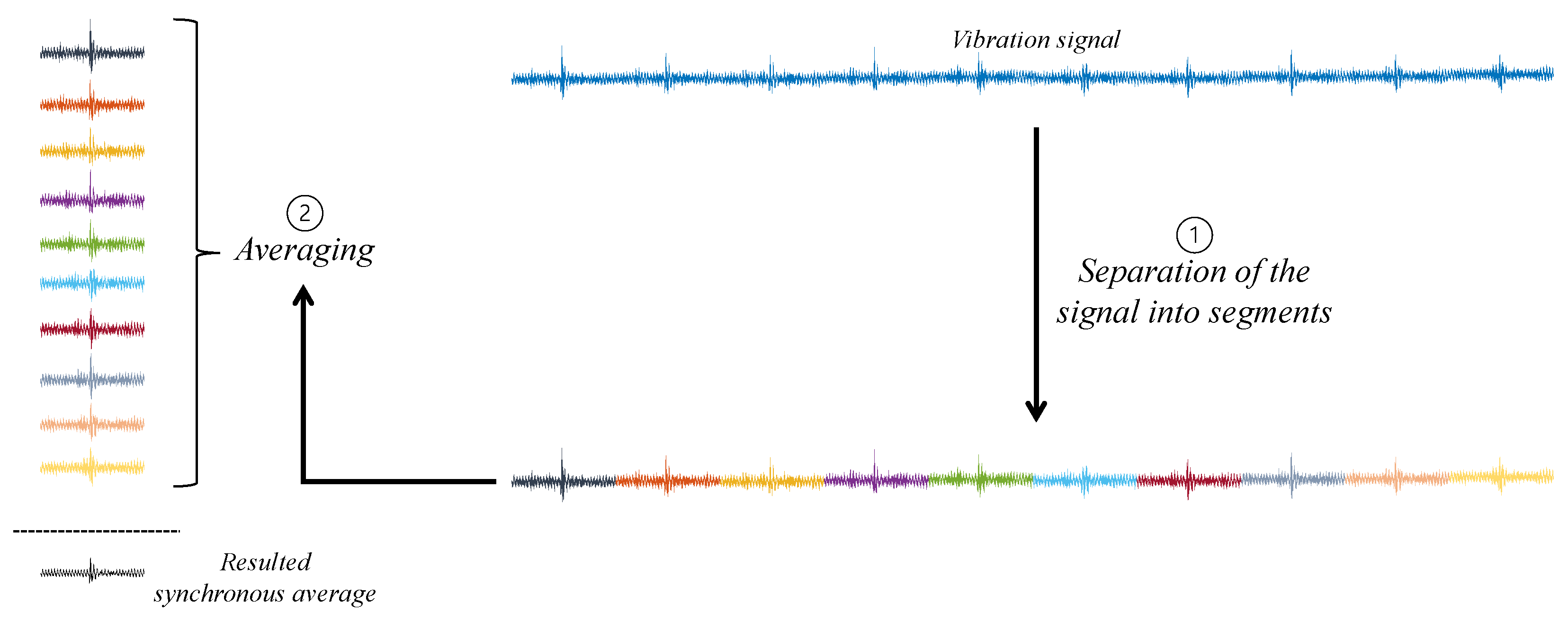

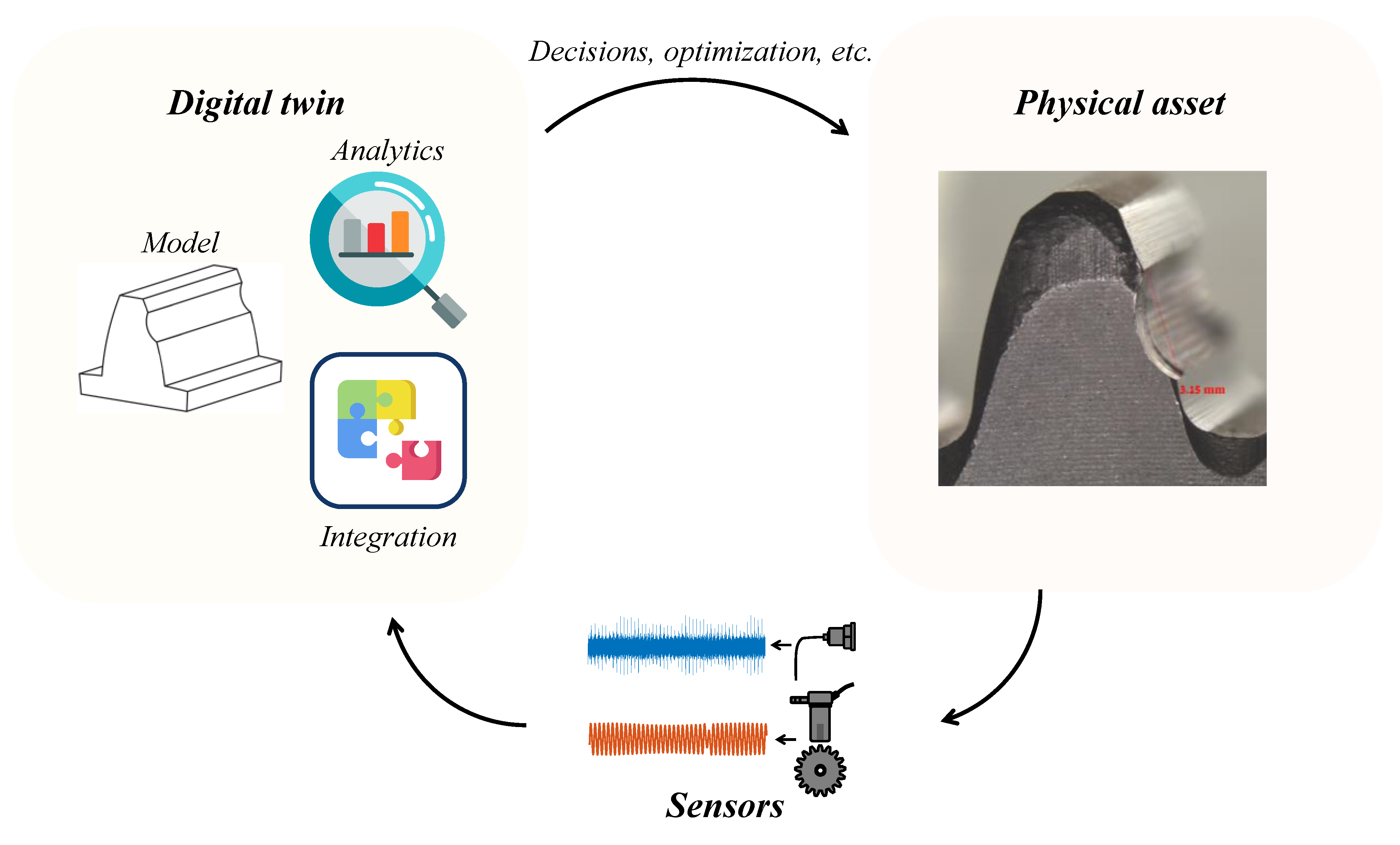
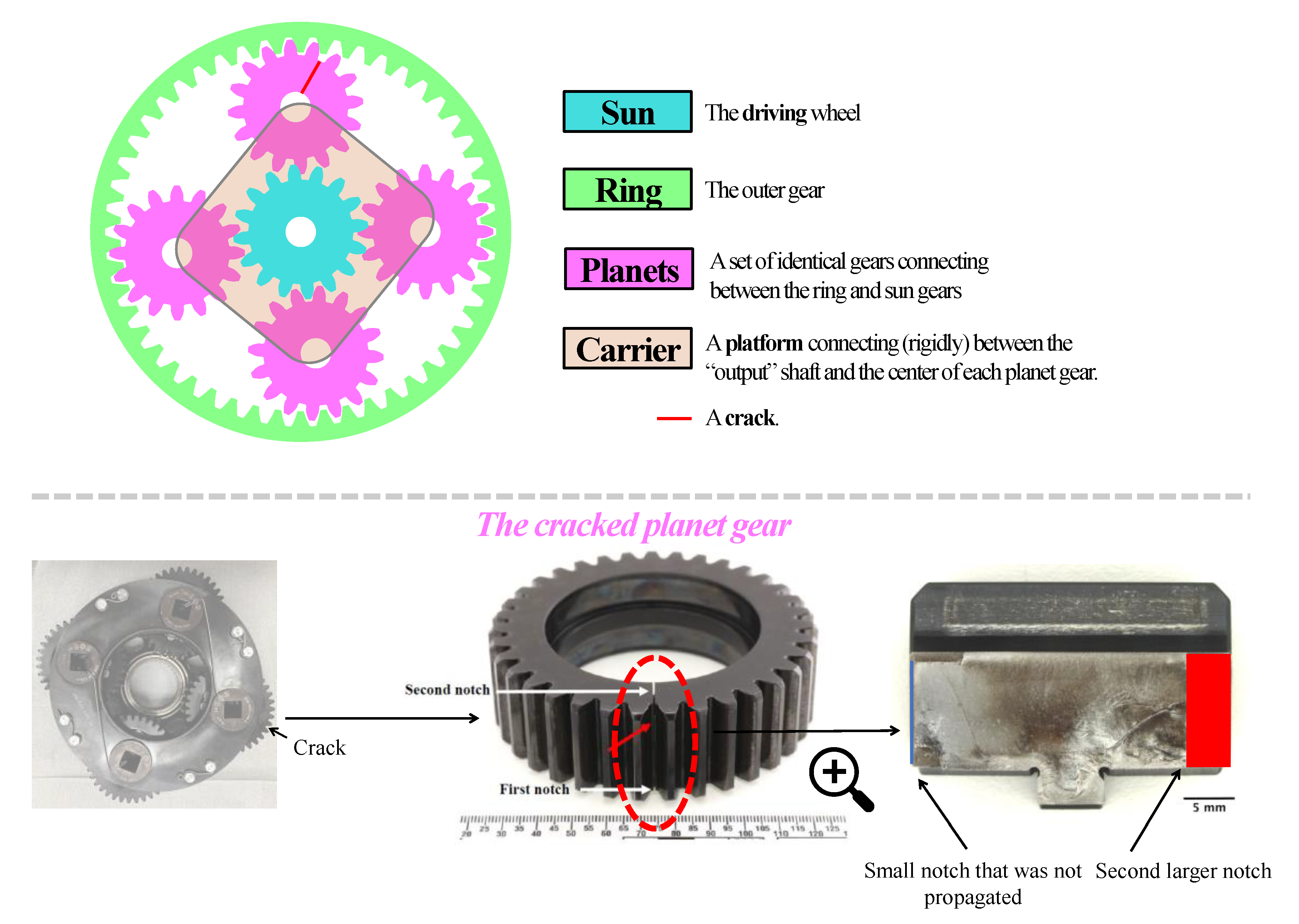
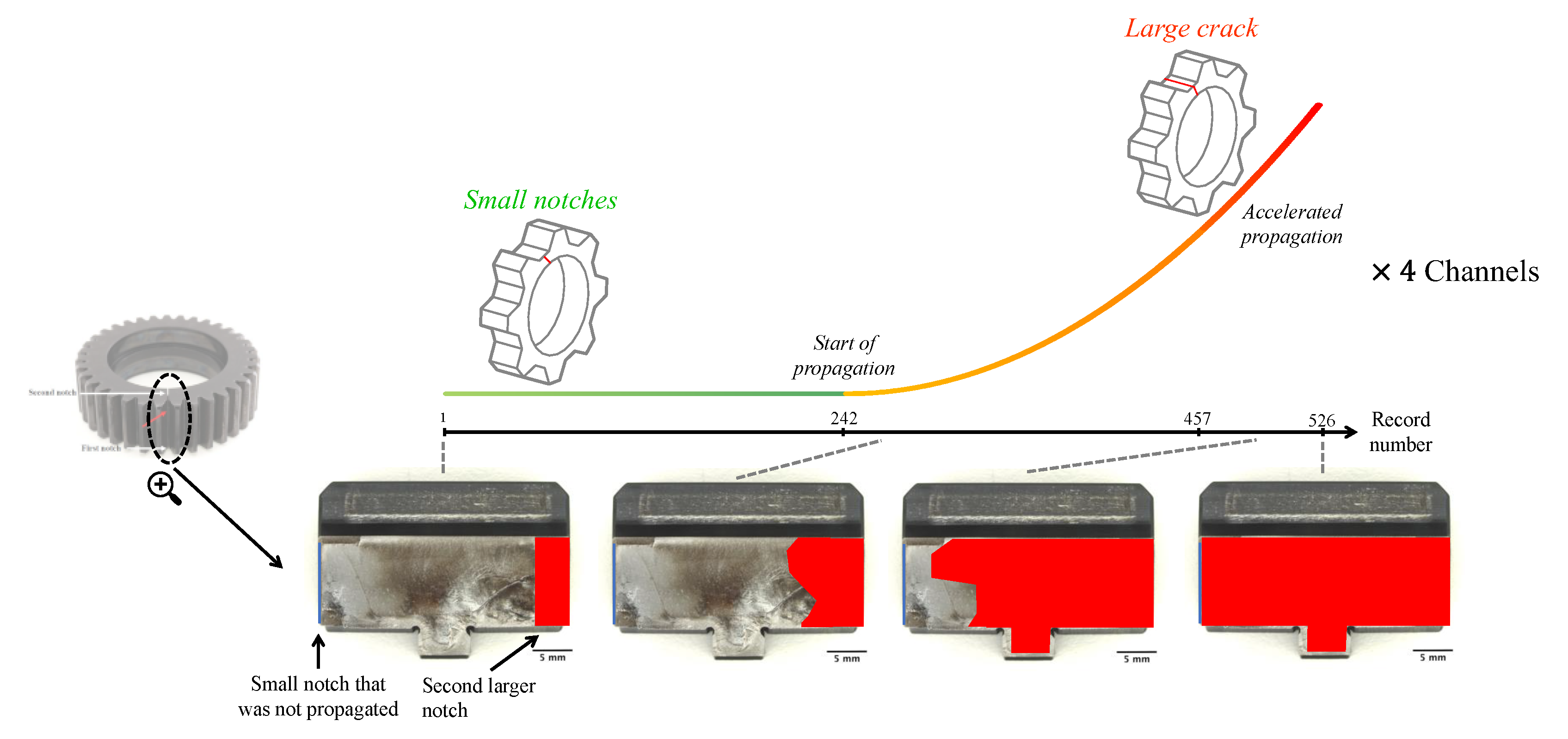
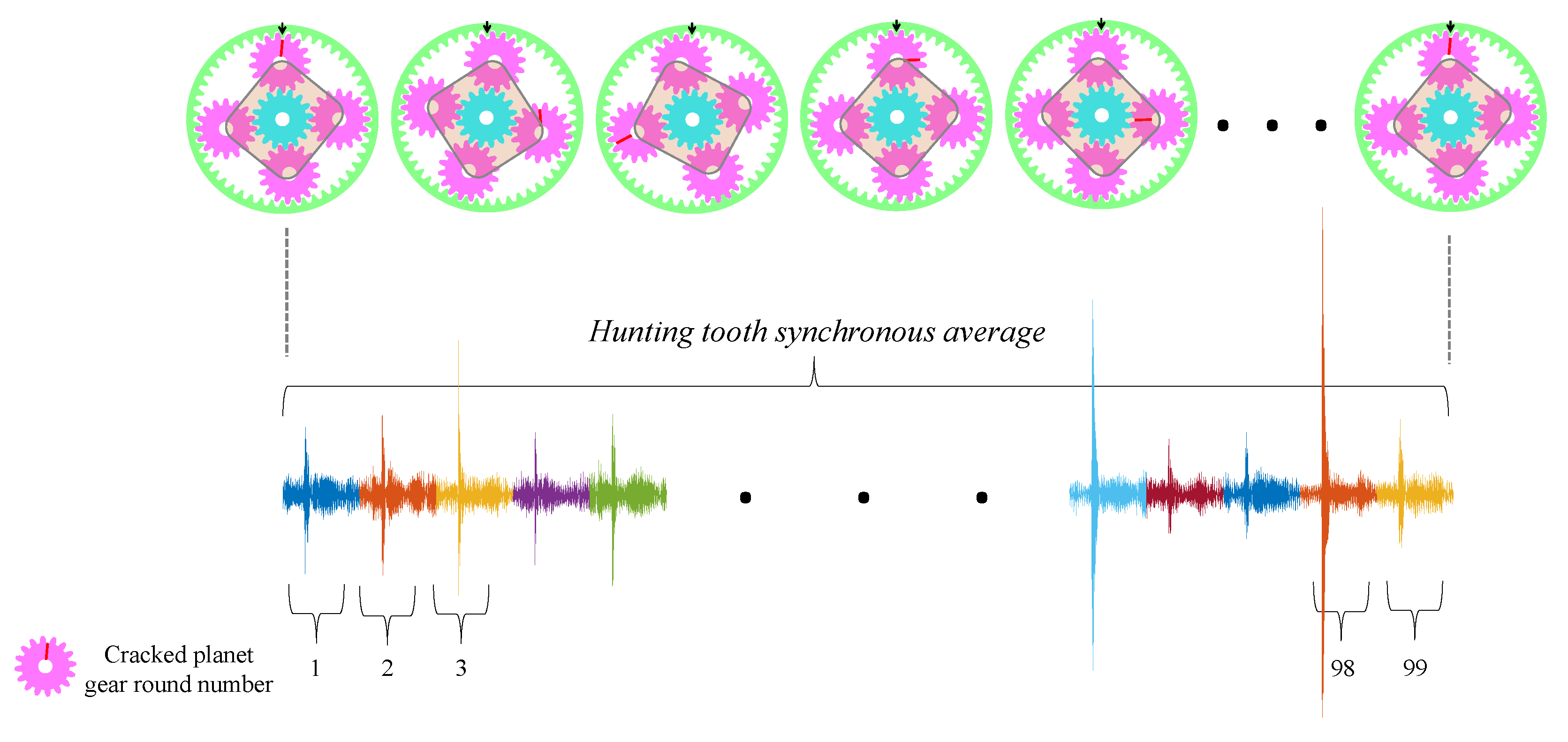


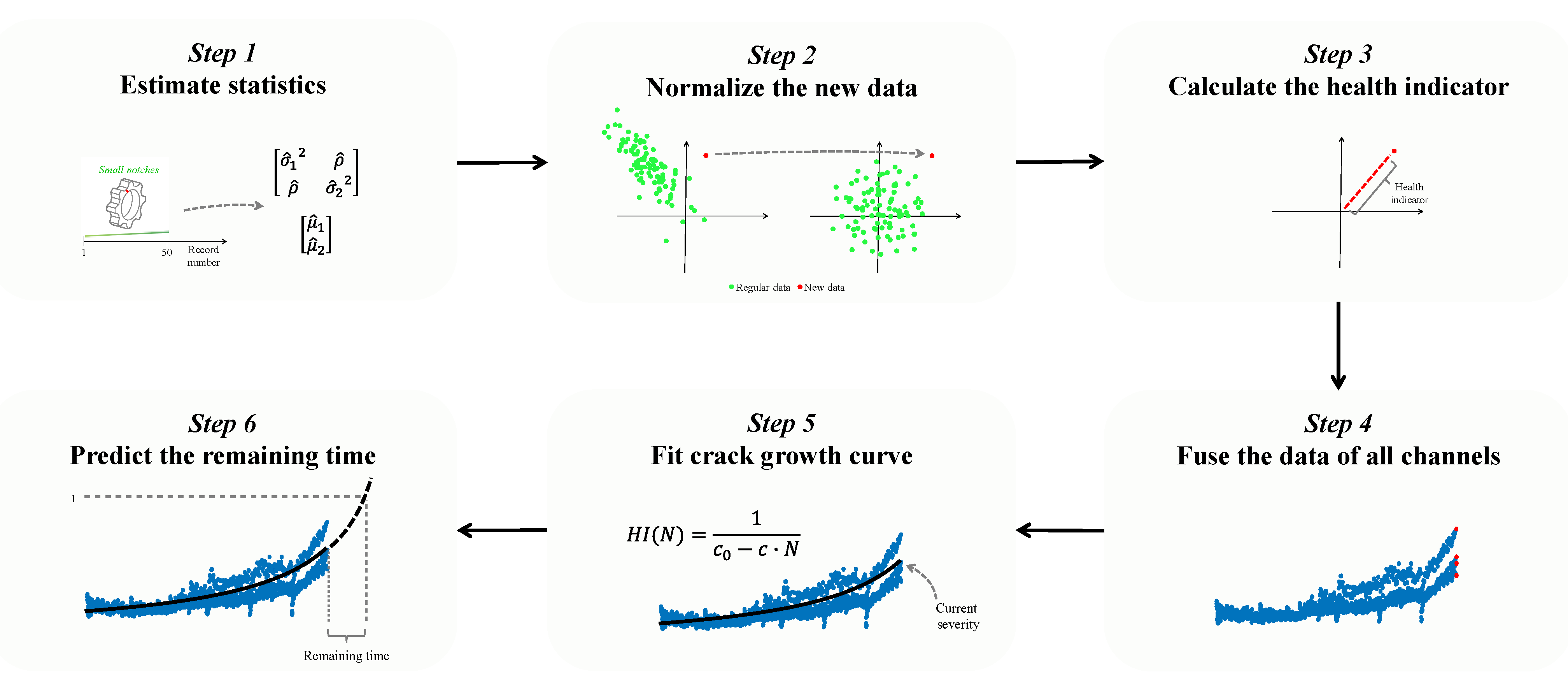

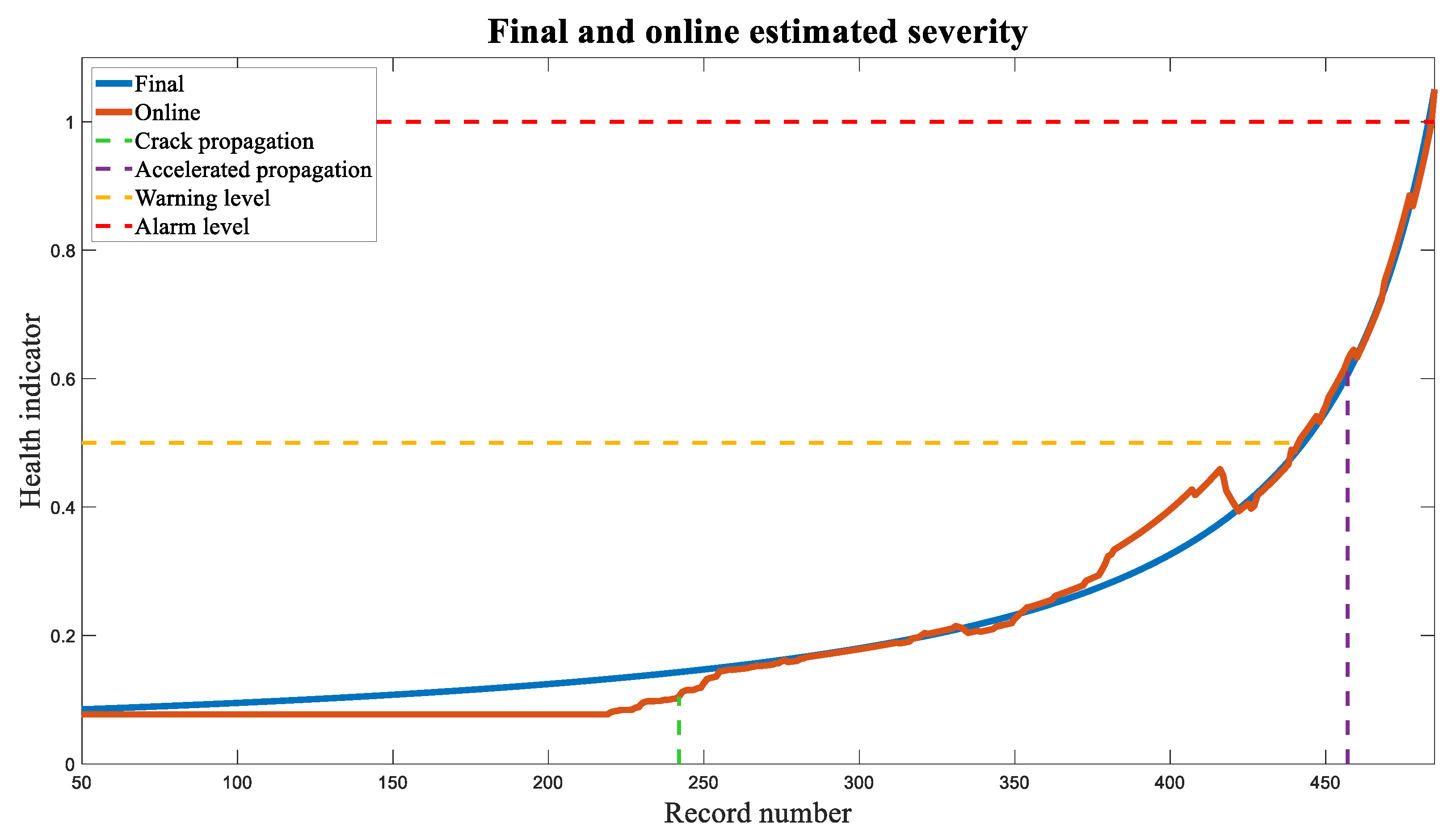

Disclaimer/Publisher’s Note: The statements, opinions and data contained in all publications are solely those of the individual author(s) and contributor(s) and not of MDPI and/or the editor(s). MDPI and/or the editor(s) disclaim responsibility for any injury to people or property resulting from any ideas, methods, instructions or products referred to in the content. |
© 2023 by the authors. Licensee MDPI, Basel, Switzerland. This article is an open access article distributed under the terms and conditions of the Creative Commons Attribution (CC BY) license (https://creativecommons.org/licenses/by/4.0/).
Share and Cite
Matania, O.; Bechhoefer, E.; Bortman, J. Digital Twin of a Gear Root Crack Prognosis. Sensors 2023, 23, 9883. https://doi.org/10.3390/s23249883
Matania O, Bechhoefer E, Bortman J. Digital Twin of a Gear Root Crack Prognosis. Sensors. 2023; 23(24):9883. https://doi.org/10.3390/s23249883
Chicago/Turabian StyleMatania, Omri, Eric Bechhoefer, and Jacob Bortman. 2023. "Digital Twin of a Gear Root Crack Prognosis" Sensors 23, no. 24: 9883. https://doi.org/10.3390/s23249883





